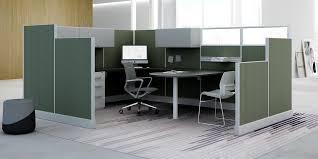In the ever-evolving landscape of office design, the shift from traditional cubicles to collaborative modular stations marks a significant transition. Gone are the days of isolated workspaces; instead, modern offices are embracing flexibility, creativity, and teamwork. Let's explore how this transformation is reshaping the way we work and interact within the office environment.
Breaking Down Barriers: The End of Cubicle Confinement
Cubicles were once synonymous with privacy and individual focus, but they also created physical and psychological barriers that hindered collaboration and communication. Today, the trend is towards open, modular layouts that encourage interaction and teamwork. By removing walls and partitions, offices become more inclusive and conducive to spontaneous collaboration, fostering a sense of community and shared purpose among employees.
Flexibility First: Modular Stations for Dynamic Workflows
One of the key advantages of modular stations is their flexibility. Unlike traditional cubicles, which are fixed in place, modular stations can be easily reconfigured to accommodate changing needs and workflows. Whether it's a small team project or a company-wide meeting, these adaptable workstations can be rearranged to support various activities, promoting agility and responsiveness in the modern workplace.
Encouraging Collaboration: Designing Spaces for Interaction
Collaboration is at the heart of modern work culture, and office layouts play a crucial role in facilitating it. Modular stations are designed with collaboration in mind, featuring shared work surfaces, integrated technology, and flexible seating arrangements. These elements encourage spontaneous interactions and idea exchange, fostering a culture of innovation and teamwork that drives organizational success.
Personalization and Privacy: Balancing Individual Needs
While collaboration is important, so too is individual focus and privacy. Modular stations strike a balance between open collaboration and personal space, offering employees the flexibility to choose how and where they work. Whether it's a quiet corner for focused tasks or a communal area for team meetings, these stations provide options for employees to customize their work environment based on their preferences and workflow requirements.
Maximizing Efficiency: Optimizing Space Utilization
In addition to promoting collaboration and flexibility, modular stations help maximize space utilization in the office. By eliminating fixed walls and partitions, offices can make better use of available square footage, reducing wasted space and lowering real estate costs. This efficient use of space allows companies to allocate resources more effectively, supporting growth and scalability without the need for costly office expansions.
Embracing Diversity: Catering to Different Workstyles
Every employee is unique, with their own preferences, workstyles, and needs. Modular stations embrace this diversity by offering a range of configurations and amenities to accommodate different ways of working. Whether it's a standing desk for the health-conscious, a cozy nook for introverts, or a collaborative hub for extroverts, these stations cater to the diverse needs of today's workforce, ensuring that everyone feels comfortable and supported in their work environment.
Conclusion: Rethinking Office Design for the Modern Era
The transition from cubicles to collaborative modular stations represents more than just a change in office layout; it reflects a fundamental shift in how we perceive and approach work. By prioritizing flexibility, collaboration, and individuality, these modular workspaces empower employees to work smarter, collaborate more effectively, and thrive in today's fast-paced, interconnected world. As offices continue to evolve, embracing innovation and adaptability will be key to creating environments that inspire creativity, foster collaboration, and drive success.
Comfortable Chic: Creating a Relaxing Reception Space with the Right Furniture
What is the significance of ergonomic furniture in turnkey office interior design?
